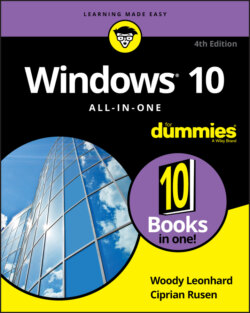Читать книгу Windows 10 All-in-One For Dummies - Ciprian Adrian Rusen, Woody Leonhard - Страница 105
Working with Settings Shortcuts
ОглавлениеThe action center contains a gob (that’s a technical term) of shortcuts at the bottom of the Notifications pane. In Figure 3-2, I count four of them. If the computer used a Wi-Fi connection, there would have been additional shortcuts for Wi-Fi, Bluetooth, rotation lock, battery saver, and brightness. The maximum number of shortcuts available varies depending on whether you're using a desktop PC, laptop, tablet, or 2-in-1; its hardware configuration; and the apps installed.
Quick actions mimic what you would find on a smartphone — airplane mode is an obvious analog — all readily accessible from the right side of the screen. In many cases, a quick action displays a Settings page, where you can change the individual setting, displays a pane on the right side of the screen (Connect, Project), or toggles a specific setting in, uh, Settings. The Screen Snip quick action opens the Snip & Sketch app, which you can use to take screenshots.
You can think of quick actions as handy shortcuts to frequently adjusted settings, or you can look at them as a testimony to the diverse way Windows 10 has settings scattered all over Hades’s half acre. You decide. Too bad you can’t add your own quick actions. The action center be a convenient place to stick your own favorite programs.
You have some — but not much — control over which icons appear at the bottom of the pane. Here’s how to exert as much influence as you can:
1 Tap or click the Start icon, the Settings icon, and then System.Or you can get into Settings from the bottom of the action center.
2 On the left, choose Notifications & Actions, and then on the right click the Edit Your Quick Actions link.The Notifications pane appears (refer to Figure 3-7).FIGURE 3-7: Editing the list of quick actions available in the action center.
3 To rearrange the icons for quick actions, just click and drag.You can’t drag a quick action off the grid.
4 To choose additional quick action icons, click or tap the Add+ button, and make a selection from the list that appears.
5 To remove a quick action icon, click or tap its pin on the top-right.
6 When you've set things the way you want them, tap Done.
Table 3-1 explains what each of the configurable quick action icons does.
TABLE 3-1 Some Quick Action Icon Results in the Action Center
| Click This Icon | And This Happens |
|---|---|
| Tablet Mode | Flips the computer to tablet mode. |
| Brightness | Adjusts the screen brightness to the level you want. |
| Connect | Searches for wireless display and audio devices — Miracast in particular. |
| All Settings | Takes you to the Settings app. |
| Battery Saver | Cycles between two battery saver modes, dimming the display. It doesn’t work if the machine is plugged in. |
| VPN | Displays the Settings app’s Network & Internet section on VPN, where you can add a new VPN connection or connect to an existing one. |
| Bluetooth | Turns Bluetooth on and off. |
| Rotation Lock | Prevents the screen from rotating from portrait to landscape and vice versa. |
| Wi-Fi | Turns Wi-Fi on and off. There’s no provision to select a Wi-Fi connection. |
| Location | Turns the location setting on and off in the Settings app’s Privacy, Location pane. |
| Night Light | Enables the night light, which filters the blue light emitted by the screen. Useful when working during the night. |
| Focus Assist | Turns focus assist on or off. When turned on, all notifications are blocked. |
| Screen Snip | Starts the Snip & Sketch app, for taking a quick screenshot. |
| Airplane Mode | Turns all wireless communication on and off. See the Settings app’s Network & Internet, Airplane Mode setting. |
| Project | Projects the image on your screen to an external display or a projector. |
